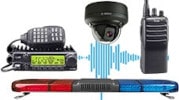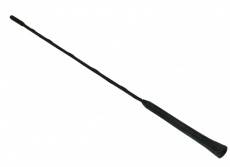Vehicle Antennas
- further categoriesThe Vehicle Antennas is used to receive radio signals from vehicles. This component can be mounted on the roof or windscreen of the vehicle, depending on its design. For many people, car radios are a source of entertainment, as we like to listen to our favourite radio stations while driving. Read more...
• Univerzal car antenna
• M5 drilled antenna
• 2 types of adapters: M5, M6
• Antenna length: 240 mm
• Spare antenna rod for car antenna
• Univerzal car antenna
• M5 drilled antenna
• 2 types of adapters: M5, M6
• Antenna length: 360 mm
• Spare antenna rod for car antenna
For others, however, the radio is also a work tool: think taxi drivers, truck drivers or even ambulances. Whatever the purpose of the device in your car, you'll need a car radio antenna. Fortunately, the antenna on most car models is really easy to replace, so it's worth getting a spare and keeping it with you.
Why do you need Vehicle Antennas?
Anyone who likes to listen to the radio while driving will be familiar with the annoying situation where a misadjusted car radio antenna spoils the driving experience. It can be noise, a reception problem or even no reception at all. In such a case, we should suspect the car radio antenna to be the culprit. Often, changing weather conditions put the car antenna to the test over long periods of time, which can cause reception to deteriorate over time. If you want to buy good antennas, you can do so conveniently from the comfort of your home or workplace at the DND Telecom web store.
What frequencies do Vehicle Antennas operate on and why is this important when buying them?
The so-called Western UHF (FM) broadcasting band, which includes our country, is between 87.5-108 MHz. In this range you can reach the most popular national and regional commercial and public radio stations, as well as smaller community radio stations. FM stations can be received by all the car radios we sell. The AM medium wave frequency range is from 531 kHz to 1611 kHz. FM technology has significantly replaced AM broadcasting over the past decades, so that only a few stations operate on these frequencies today. Without being exhaustive:
Kossuth Radio: Solt, 540 kHz
Dankó Rádió: Miskolc, 1116 kHz
Nationality Radio: Győr, 1350 kHz
What radio frequencies can be received with the Vehicle Antennas?
With the car antenna you can receive two analogue radio frequencies, but nowadays we also have to talk about digital broadcasting. One is FM and the other is AM. But let's get into the details. FM stands for "frequency modulation", which means modulated frequency. The technology is nearly a century old, with the first FM radio broadcasts having taken to the airwaves in America in 1933. Since then, FM has become one of the most widely used frequency bands. Its main advantage is its ability to cover a wide reception area (80-90 km) while providing excellent quality.
The history of amplitude modulation, or AM for short, dates back to 1920. Although the quality of transmission is poorer than FM, it can be used to transmit over long distances.
What you need to know about digital broadcasting
DAB and DAB+ stand for Digital Audio Broadcasting, an acronym that stands for Digital Audio Broadcasting. Although this type of radio broadcasting ceased in Hungary in 2020, it is becoming more widespread and popular abroad. And not without reason, as digital broadcasting has significant advantages over both AM and FM radio.
The most important of these is that DAB and DAB+ systems allow completely noise-free transmission, meaning you can listen to your favourite radio station in perfect sound quality. They can also transmit a range of extra information (e.g. traffic news) and 10-18 stations can be received on a single frequency. Although DAB and DAB+ radio stations do not require a separate antenna, they can only be received with the right equipment.
A wide range of Vehicle Antennas available from DND Telecom webshop
.
Car antennas are only a small part of our range. It's worth a browse if you need a different type. For example, a compatible antenna is essential for CB radio and we have an outstanding range of products in our webshop. You can buy a state-of-the-art Wi-Fi antenna, but we're also here to help if you need a shortwave, VHF, GPS or airband antenna.
Our staff will give you all the help you need with your purchase, and of course you can count on us for installation!
How can we choose an antenna that is compatible with our car?
Car antennas provide reception of AM and FM stations via the radios built into the vehicles. The principle of operation of this type of antenna is based on the transmission of electromagnetic waves that generate a sound image through the car radio and its associated speakers. An antenna amplifier integrated into the vehicle antenna is also important to ensure a signal level increase and thus improve radio reception. Antenna models fitted in modern vehicles also improve mobile phone reception and can be used to receive GPS signals.
As mentioned above, we distinguish between two types of radio waves. That being said, the best choice when shopping is of course a universal car antenna, which can be conveniently obtained from the DND Telecom webshop. These antennas are fully compatible with different car types. Don't forget about the connection when choosing a car antenna. Car antennas are often offered with threaded adapters, so they can be fitted to a wide range of car models.
What is the difference between short and long antennas and which one should you choose?
Before buying a car antenna, consider which antenna design you want to choose. Long antennas provide good reception quality. There are also short antennas on the market, which can be either rod or shark fin shaped. These are usually no longer than 10 cm and offer poorer reception performance compared to longer antennas. Remember, however, that it always depends on the model. Due to their low height, short car antennas are less likely to break than longer versions.
What are the mounting options? How easy is it to install a car aerial or do you need professional help?
Fortunately, if you have a little bit of manual dexterity, you can easily install car antennas on your favorite vehicle yourself. In order to be able to install the right car antenna on your car, the first step is to determine where to install it. Rod and shark fin antennas are usually mounted on the roof of the vehicle, while window antennas are often fixed to the windscreen or rear window with adhesive film.
If you want to install a fixed car antenna, it is much more difficult to install because you usually have to install a long antenna cable. As this type of installation also involves tampering with the vehicle's on-board electronics, we recommend that only an experienced mechanic or a specialist workshop should carry out the installation.
DND tip: If you are buying a universal antenna, to be on the safe side, you should measure the thread diameter of the antenna that was previously installed or fitted to your vehicle before you buy it.


